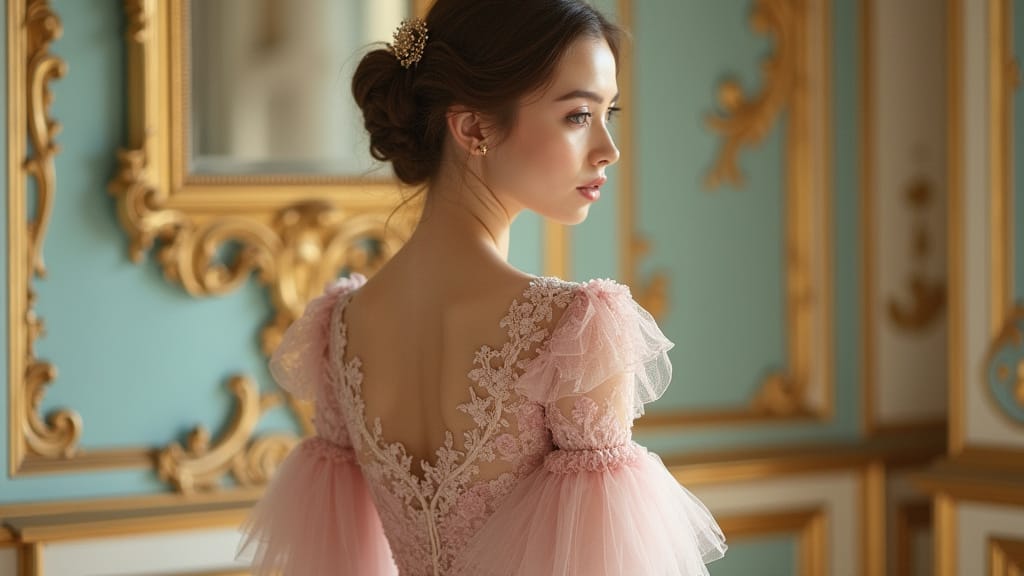Struggling to find that favorite shirt or pair of shoes in your cluttered closet? This article dives into a bunch of practical closet organization ideas that will help you reclaim your space and keep your wardrobe effortlessly sorted. Expect simple, effective strategies for decluttering, smart storage solutions, and tips to maintain an organized closet that makes getting ready a breeze.
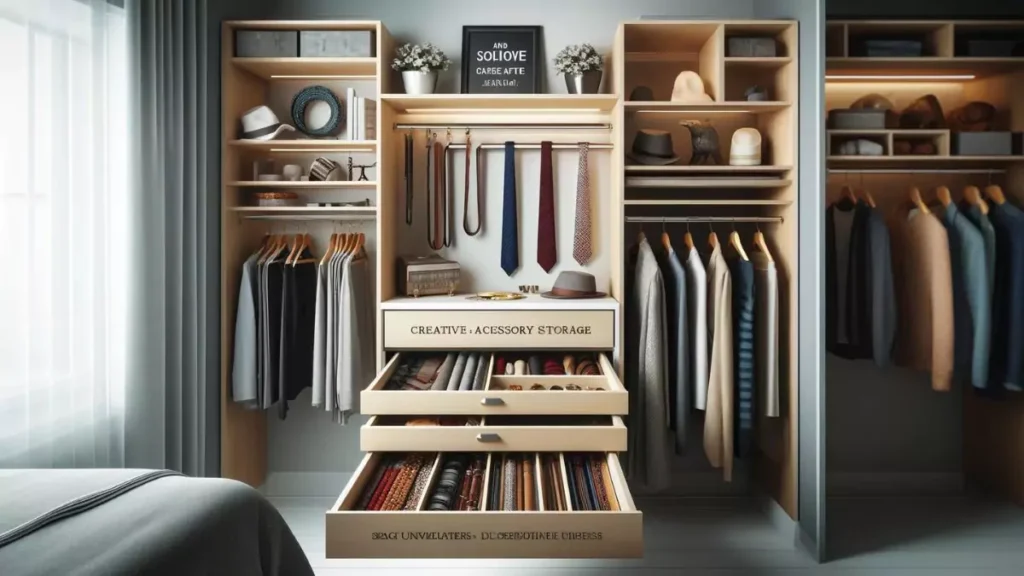
Table of contents
Key Takeaways
- Decluttering your closet is the essential first step toward organization, which includes removing items you don’t use or love, categorizing clothes, and adhering to the one-year rule to create a minimalist space.
- An efficient closet layout maximizes space by using vertical storage, creating designated zones, and smartly storing accessories; while capsule wardrobe concepts focus on keeping a limited number of versatile and beloved items.
- To maintain a consistently organized closet, it’s important to adopt regular mini-cleanouts, apply an in-and-out rule with new purchases, and personalize your closet with strategic lighting, color coding, and favorite displays.
Decluttering Your Space: The First Step to an Organized Closet
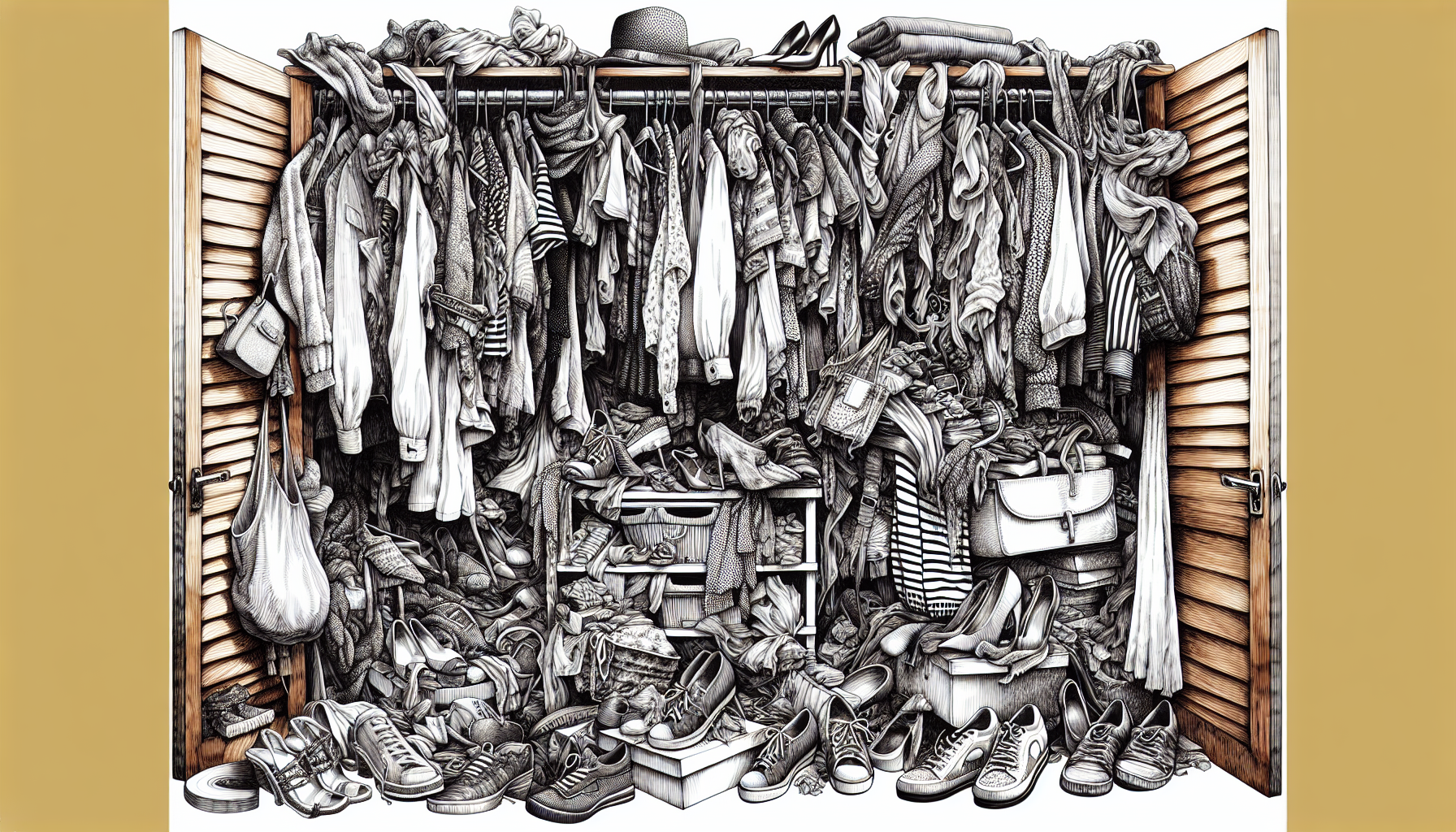
Embarking on the path to a minimalist closet starts with the process of decluttering. By eliminating what’s unnecessary and choosing only that which you find valuable, it can alleviate stress and create peace of mind. Imagine your wardrobe containing only items that are used frequently and cherished – this thought in itself is quite liberating.
Initiate by extracting every piece from your wardrobe space. This strategy gives you an uncluttered viewpoint, enabling you to selectively re-introduce only those articles that are indispensable or bring joy into your life, as well as those necessitating a Try-on session for evaluation. Approach this task unhurriedly. Be contemplative about whether each article is vital, treasured or needs another fitting before deciding its place in your collection.
Maintain a receptacle like a bag or box within easy reach inside your closet designated for discarding undesired pieces promptly. When filled up, make sure these items get donated! Adopting such practice facilitates continuous refinement towards achieving an ever-minimalist storage area for clothing and accessories.
Creating Piles for Purpose
In the process of decluttering, it can be helpful to organize your clothing into distinct categories to make the procedure more efficient.
- Retain
- Give away
- Vend
- Stow seasonally
Once you feel you’ve made a decision about each item of clothing, assign it to a category based on how much you value it, how often you wear it, and its current state.
After completing this initial step in categorizing and being rid of purging your wardrobe, the focus should transition towards efficiently arranging and storing whatever clothes are left.
The One-Year Rule
In the realm of maintaining an organized closet, adhering to the one-year guideline is key. Should you discover that you haven’t worn a particular piece of clothing within a year, it might be wise to part with it. Often, sentimental ties or the hope that you may wear these clothes in the future make this difficult, even when they’ve been unworn for more than twelve months. Consider that discarding such items contributes significantly to achieving a closet free from clutter and well-arranged!
Sentiment vs. Practicality
Maintaining a minimal closet requires navigating the fine line between cherishing memories and embracing functionality. Conserve only those sentimental pieces that carry the greatest emotional value, ideally confining them to a single box to keep your wardrobe free from emotional clutter.
The KonMari method could be an effective strategy for your decluttering process. It encourages letting go of items that fail to ‘spark joy.’ Bear in mind that decluttering aims not solely at freeing up space but also at improving your mental state.
Designing Your Dream Closet Layout
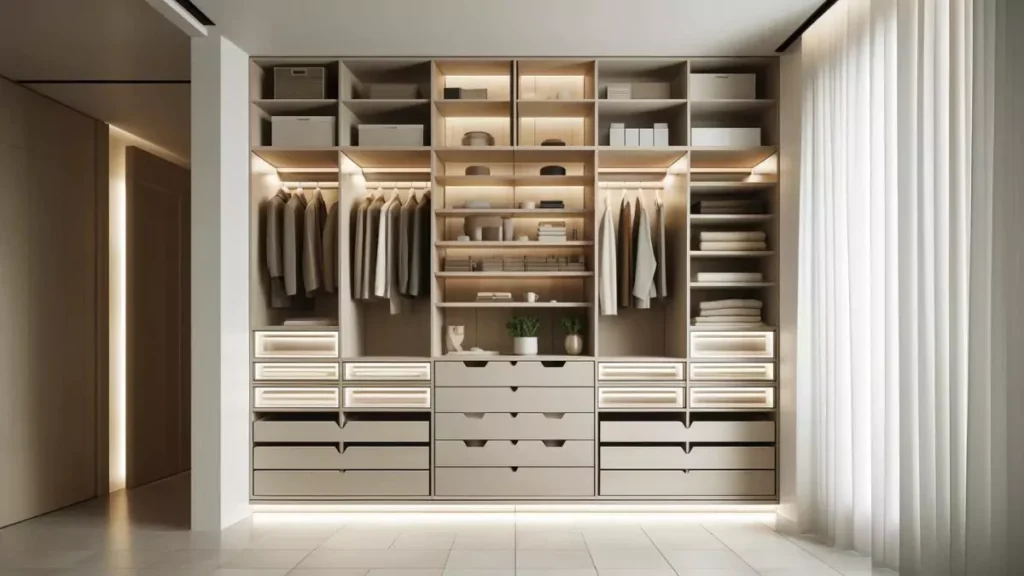
Once you’ve eliminated the excess, it’s time to construct your ideal closet space. Make the most of entire walls within your closet by integrating a combination of shelves, hooks, and rods that will maximize every inch. For more efficient organization consider tailor-made solutions with vertical storage options and tiered hanging areas designed specifically for various zones in your closet. Organize clothing into distinct sections based on their length — segregating shorter from longer pieces can reveal valuable floor real estate suited for installing additional drawers or shoe organizers.
Don’t overlook the potential of wall-mounted shelving positioned over hanging rods as they offer supplementary storage possibilities. Introduce multiple levels of hanging rods to accommodate different lengths and types of clothes effectively. Achieving functionality doesn’t have to sacrifice style. Coordinate your items by color coordination or group them according to use for an aesthetically appealing arrangement within your wardrobe space. Lastly, sort out attire by frequency-of-use categories so selecting outfits becomes a smoother process in day-to-day life.
Utilizing Vertical Space
By maximizing the use of vertical space, your minimal closet’s utility and visual appeal can be significantly improved. By adding shelf dividers to the upper shelves, you’re able to create separate compartments which prevent piles of clothing from falling over while ensuring they are easily accessible. Utilizing storage options above the closet door or along the higher sections of walls provides a perfect place for items that you don’t need to access regularly, making efficient use of all available vertical spaces.
Incorporating high shelving allows for better utilization of bare wall areas, providing an ideal spot for keeping seldom-used items out of the way. Introducing an additional hanging rod within your closet can effectively add or double your capacity for suspending shorter garments such as shirts and trousers. Installing corner shelves or rods makes it possible to convert overlooked corners into valuable storage areas in your minimalist wardrobe setup.
Zoning Your Closet
Establishing specific areas for varied categories of clothes and accessories enhances orderliness and streamlines the search process. Set aside distinct sections for:
- Business attire
- Leisure clothing
- Evening wear
- Fashion accessories
Within each designated section, organize clothing by kind, such as grouping all hanging business dresses together and placing related work footwear in proximity.
Dividing your wardrobe into zones according to how often you wear certain pieces ensures that those items worn on a regular basis are readily available, thus accelerating the decision-making process when choosing an outfit.
Clever Use of Accessories
Ensure your closet is a haven for style by effectively organizing accessories and amplifying your storage options. Here are strategies to enhance the organization of these vital fashion complements:
- Install hooks or pegs along the interior walls of your closet, or attach them to the rod, providing a perfect spot to drape belts, scarves, and necklaces.
- Incorporate bins and baskets as homes for tucking away smaller accessories like wallets and watches.
By integrating these methods into your space, you will not only streamline accessory storage, but also maintain an organized environment that simplifies locating and selecting items from your collection.
Implementing a Capsule Wardrobe Strategy
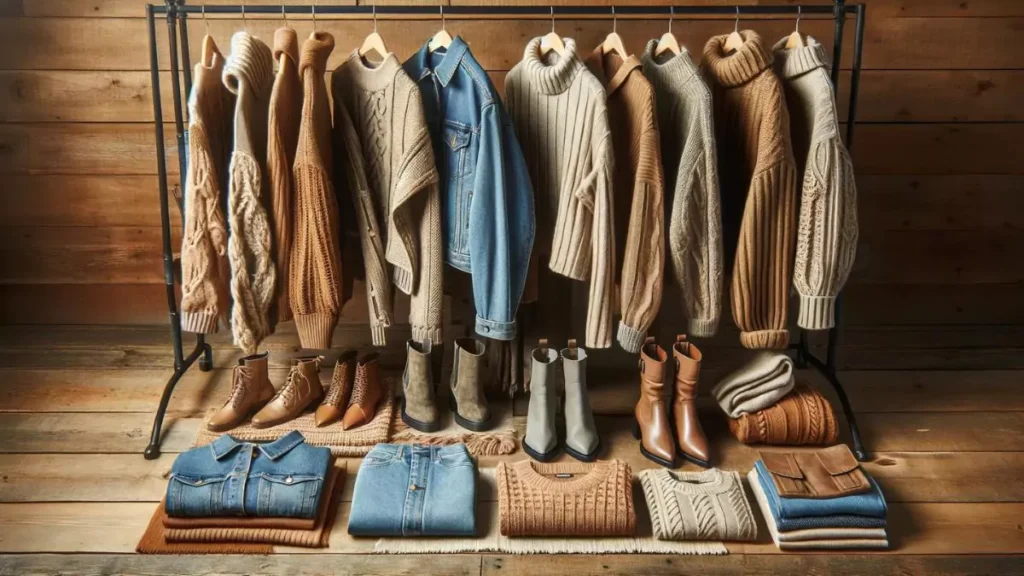
Having achieved an organized and streamlined space within your wardrobe, let’s explore the capsule wardrobe approach. This concept hinges on crafting a minimalist assemblage of clothing that encourages numerous ensemble possibilities with just a small variety of versatile pieces. The emphasis is placed on essential garments that are not only cherished but also frequently used.
To initiate your journey towards creating a capsule wardrobe, it’s crucial to perform a thorough assessment of what you currently own in order to pinpoint those items which feature heavily in rotation and resonate strongly with personal style — these will form the foundation of your refined collection. When selecting these items, consider their:
- Adaptability
- Harmony within a chosen color scheme
- Balance between timeless staples and current trends
- Durability
- Congruence with personal style preferences and body shape
Defining Your Core Essentials
Commencing the assemblage of a capsule wardrobe hinges on identifying pivotal staples. Essential elements should encompass enduring, utilitarian, and adaptable pieces of clothing such as:
- Pristine white shirts
- Jeans with straight-leg cut
- Expertly tailored blazers
- Dresses that can adapt to multiple scenarios
- Trousers with pleats
- Sleek tank tops
- Iconic denim styles
- Trench coats for layering
- Sweaters that offer comfort
For streamlined coordination of outfits, opt for primarily neutral shades within your essential attire collection in the wardrobe while infusing it with one or two supplementary hues that enhance your natural skin tone.
Key shoe wear necessary to round out a capsule wardrobe involves:
- Ballet flats for elegance and ease
- Clean-cut white sneakers
- Laid-back driving loafers
- Multi-purpose sandals
These selections present varied options suitable for different events and day-to-day activities. It’s important to curate items reflecting current lifestyle needs over aspirational personas or those past their prime. Discard rarely worn garments or those not congruent with your personal style ethos from the closet.
Seasonal Swaps
A capsule wardrobe adapts to the shifting seasons, so it’s essential to choose adaptable items that can be layered—such as tank tops for summer heat and cozy sweaters when winter arrives—to facilitate seamless transitions between seasonal apparel.
Smart Storage Solutions That Save Space
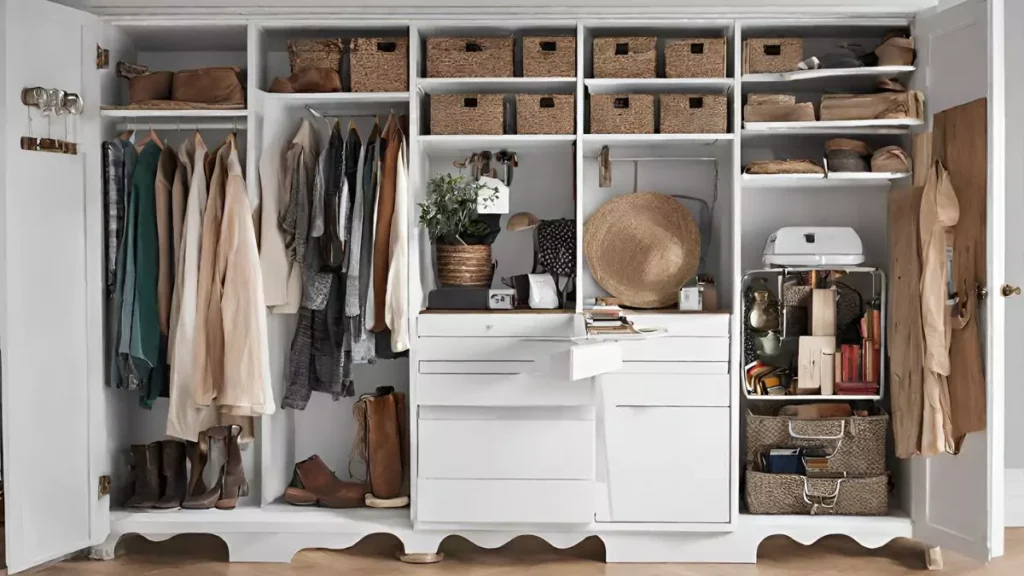
Maintaining an organized closet is essential, even for those with a minimal wardrobe. To keep shoe collections tidy and conserve floor space within the closet, wall-mounted racks or shelves are optimal storage solutions.
For smaller closets in particular, IKEA offers several options designed to save space.
- Cabinets that mount directly onto the wall
- Metal shelves that stand on their own
- Storage systems that are modular and customizable to accommodate different sizes of items as your storage requirements change over time.
Ottoman beds featuring gas-lift hydraulics present a savvy option for storing bulky items you don’t use often by taking advantage of the under-bed area.
Under-Bed Storage Tactics
Storing items under your bed can be an effective way to save space. You might consider several under-bed storage solutions.
- Beds designed as divans that come with integrated drawers
- Ottoman beds featuring ample storage
- Drawers that slide out for easy access
- Traditional storage chests
- Bags that use a vacuum to compress contents for efficient packing
- Baskets allowing breathability, crafted from natural fibers like wicker, rattan or seagrass
By concentrating on the clothing you wear during the current season and forming a capsule wardrobe, you can utilize this under-bed area to stow away clothes not in immediate use while keeping your bedroom and main wardrobe clutter-free. Leveraging these creative options enables optimal organization and full utilization of available living spaces.
For neatly arranging garments and shoes, here are some ideas.
- Lidded bins designed specifically for placement under beds offer protection against dust.
Wheeled crates or plastic containers make it possible to unlock more room within your closet.
- Pull-out compartments or segmental organizers provide tailor-made areas for orderly shoe and boot storage.
Subscribe today and get a special gift, just for you!
Multi-Use Hangers & Hanging Techniques
Optimize the space in your closet by utilizing versatile hangers that accommodate a range of clothing pieces. These multi-purpose hangers provide effective storage solutions and facilitate quick retrieval of garments. Key varieties include tiered, clip, and cascading styles, each specifically designed to meet diverse hanging requirements for different types of items.
Fold vs. Hang Decisions
Choosing to hang or fold clothes is crucial for keeping a closet tidy. Store garments based on their fabric type, weight, and the arrangement of your closet space. It’s best to hang items that have form and are susceptible to wrinkles in order to preserve their shape.
Conversely, it’s advisable to fold heavy knitwear because if they’re hung up, they might stretch out or lose their original contours. By folding and stacking substantial articles such as sweaters instead of hanging them, you can save valuable rod space and enhance the organization within your closet.
Maintaining an Organized Closet Over Time
Maintaining your now minimalist and beautifully ordered closet is the next step. By establishing certain shopping guidelines and rules for your wardrobe, you can reduce clutter and make the process of choosing an outfit more straightforward.
By periodically assessing and updating what’s in your office wardrobe to match how you currently use it as well as your personal taste, you’ll keep its usefulness intact, making sure that this space remains accommodating to your requirements.
The In-and-Out Rule
To preserve a minimal closet, adhere to the in-and-out rule. This principle dictates that whenever you introduce a new item into your wardrobe, an older piece should be taken out. Maintain a bag for the pieces that no longer suit your taste and once it reaches capacity, donate its contents. For those items about which you’re uncertain, place them in an ‘outbox’ and make time to evaluate them at another point.
It’s important to exercise this rule categorically. Each addition of an item within one category necessitates the removal of another from that same group.
Regular Mini-Cleanouts
Maintaining a tidy and organized closet is key to avoiding clutter, which can be achieved through regular short cleaning sessions. It’s important to periodically remove clothing that you no longer wear or that doesn’t fit correctly anymore. Also, items needing alterations but have been neglected should be discarded in these routine purges.
By conducting consistent mini-cleanouts, possibly each day, one can sidestep the buildup of clothes and circumvent overwhelming large-scale organization efforts. This approach ensures the continuous management of your wardrobe without worry of letting it become stressful due to excessive accumulation of items.
Mindfulness in Purchasing
It is essential to consider carefully each potential new purchase for your home or closet, as doing so helps preserve its organization and mitigates concerns over whether the new item will integrate seamlessly with your current arrangement while also serving a real purpose.
Personalizing Your Closet Space
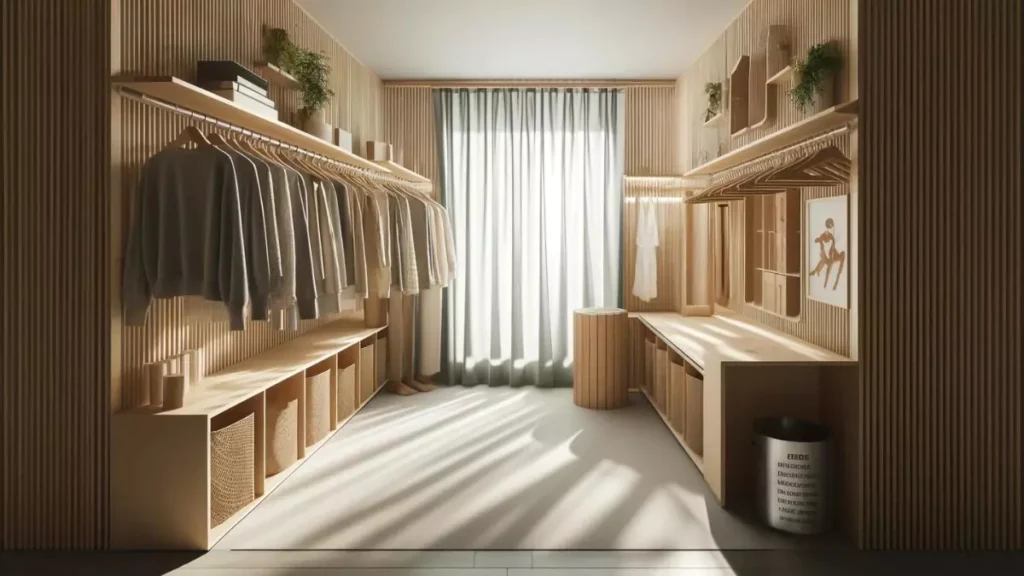
Having mastered the essentials, it’s time to infuse your minimal closet with a bit of character. Consider these suggestions.
- Develop an organizational method that complements how you get dressed, whether that means sorting by color or by type of garment. This will tailor your wardrobe space to fit your personal style.
- Introduce vibrant hues into your clothing storage area with painted walls or colorful bins for an invigorating splash of personality.
- Opt for chic hardware like ornate knobs or designer handles to elevate the sophistication level within your minimalist wardrobe sanctuary.
By weaving in these customized elements, you’re on track to creating not just a functional but also aesthetically pleasing personalized closet.
Let’s not overlook lighting! Strategic placement of lights can significantly improve both visibility and ambiance when selecting outfits from within the confines of our thoughtfully curated closets.
Color Coding for a Visual Appeal
Organizing a closet by color not only improves its aesthetic but also results in a more orderly wardrobe setup. When clothing is sorted according to hues, picking out ensembles becomes straightforward and it’s easy to spot the choices one has within specific color segments. This method may even prompt creative new outfit pairings.
Maintaining an organized clothing collection becomes effortless with a color-coded system because:
- It streamlines returning items to their designated spots
- It provides an all-encompassing view of one’s entire array of garments
- It underscores the distribution of different colors and varieties of clothes.
Displaying Favorite Pieces
Showcase your cherished apparel and adornments to infuse a touch of individuality into your space. Items like:
- sunglasses
- a tote bag
- a leather belt
- a black handbag
- a sling bag
Not only do they act as essential elements of one’s wardrobe, but also double up as ornamental pieces within the confines of your closet.
Lighting and Mirrors
Incorporating additional lighting and strategically placed mirrors can significantly improve both the utility and ambiance of your closet space. By intensifying the light in a closet, you create an illusion and feeling of expanded space that appears more inviting. Essential to altering both the practicality and visual appeal of your closet is appropriate illumination.
Thoughtfully installed mirrors offer convenience for outfit choices while also enhancing the reflection of light within the interior, amplifying its brightness.
Expert Tips and Tricks for Optimal Organization
To ensure your room or closet is maximized for space and stays organized, implementing a few expert strategies is crucial. Install corner shelving to transform those peculiar nooks into effective storage zones—this makes the most of every available square inch. Utilizing shelf dividers can keep clothes neatly stacked on shelves. This takes advantage of vertical real estate while also keeping your stacks of stuff from getting messy.
Aesthetics should not be overlooked when organizing. It’s important to find harmony between functionality and visual pleasure in your closet organization method by choosing storage options that coordinate well with each other in terms of color scheme, materials used, and overall design aesthetics. This approach marries practicality with style for an optimally arranged space.
The Art of Folding
Beginning with the refinement of folding techniques is essential. Embracing certain folding practices can notably improve spatial efficiency within drawers and shelving units. Marie Kondo’s KonMari method promotes the technique of transforming clothes into compact, stand-up rectangles, which simplifies both identification and retrieval of garments while optimizing space in storage areas.
For heavier clothing such as sweaters, employing a rolling strategy for storage not only aids in mitigating creases, but also conserves valuable space.
Accessory Integration
Proceed by incorporating elements such as hooks and pegs to optimize your storage capacity and maintain order. By mounting hooks on the inner side of closet doors, you create an accessible means to sort and store numerous items. Tailor-made organizers for closets can be fitted with these features, offering dedicated spots for smaller accessories.
Employing purse-specific hooks is advantageous in preserving the structure of handbag straps, thus extending their durability. Arranging a personalized organizational scheme within your closet allows not only efficient placement but also displays distinctive collections of accessories with inventive style.
Handling Odds and Ends
Utilizing transparent acrylic or glass shelving can significantly enhance the visibility and accessibility of those accessories for which you haven’t found a suitable storage spot.
The key is to identify an organizational method that aligns perfectly with your individual needs!
Summary
To sum up, the process of converting an overcrowded wardrobe into a streamlined, minimalist area can be straightforward and rewarding. Every phase—from purging unnecessary items to planning your closet’s design, adopting a capsule wardrobe system, and ensuring ongoing tidiness—takes you closer to achieving a closet that fulfills both your practical requirements and contributes to your sense of peace and happiness. The path you walk towards establishing a minimal closet is as much about improving your emotional health as it is about eliminating clutter.
Frequently Asked Questions
Is it cheaper to build or buy a closet system?
Opting to purchase a stock closet system and undertaking the installation on your own typically results in cost savings by eliminating the expenses associated with employing a professional closet designer.
How is a closet supposed to be organized?
In order to maintain a well-ordered closet, arrange your clothes according to their hue, type, or size. This organization strategy ensures that you can quickly locate the item you’re looking for and keeps the space tidy.
What is a capsule wardrobe?
A capsule wardrobe consists of a carefully selected assortment of essential clothing items that are designed to be versatile and interchangeable, thus amplifying the number of possible outfit configurations. It emphasizes the importance of cherishing and adoring each piece within the collection.
What is the one-year rule?
The rule of one year serves as a criterion for pinpointing pieces in your wardrobe that have not been worn over the last twelve months, suggesting these items might be superfluous and could be purged from your closet.
How can I utilize vertical space in my closet?
Consider making the most of your closet’s vertical area by adding shelf dividers, utilizing storage above the closet door or on higher sections of walls, and installing elevated shelves to capitalize on unused wall space.







